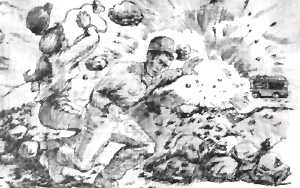Mining Product: Toolbox Training on Flyrock Awareness
Original creation date: December 2005
Flyrock has killed and injured people. Flying material, both within the blast area and outside it, is responsible for over half of all blasting-related injuries and fatalities. Records from the Mine Safety and Health Administration for 1994-2001 show that in surface mining, 32 people were killed or badly hurt because the blast area was not cleared. Another 17 people were injured or killed by rocks that were thrown outside of the blast area. This total (49 people) is greater than the combined total of the other blast accident causes in mining (premature blast, transporting explosives, fumes, and misfires). Flyrock is a potential hazard anytime and anywhere there is blasting.
The objective of this toolbox training on Flyrock Awareness is to improve blast safety by providing information about blasting to those who work around blast sites.
Materials included in file download:
- Instructor Copy- Includes four pamphlets with tear-off cards
- Toolbox Lesson A - What is flyrock?
- Toolbox Lesson B - Recognize Blast Area and Signals
- Toolbox Lesson C - Clear the Blast Area
- Toolbox Lesson D - Protect Yourself
- Student Handout - Worker Hazard Alert Pamphlet
- Student Handout - Visitor's Hazard Alert Pamphlet
One side of each pamphlet describes the dangers and safety problems that could exist around blasting. The reverse side has a list of best practices and a set of talking points. There is a set of postcards for three of the pamphlets, which contain related photos and drawings. There is also a record sheet, which can be photocopied and used to record training activities.
All materials are designed for duplex (double-sided) printing.
Authors: NIOSH
Audience: Workers, blast crew members, trainees
Reference - December 2005
NIOSHTIC2 Number: 20029875
Pittsburgh, PA: U.S. Department of Health and Human Services, Public Health Service, Centers for Disease Control and Prevention, National Institute for Occupational Safety and Health, 2005 Dec
See Also
- An Analysis and Prevention of Flyrock Accidents in Surface Blasting Operations
- Blasting and Explosives
- Blasting Injuries in Surface Mining with Emphasis on Flyrock and Blast Area Security
- Blasting Safety - Revisiting Site Security
- Dangers of Toxic Fumes from Blasting
- Fatal Accidents Due to Flyrock and Lack of Blast Area Security and Working Practices in Mining
- Programmable Electronic Mining Systems: Best Practice Recommendations (In Nine Parts): Part 3: 2.2 Software Safety
- A Summary of Fatal Accidents Due to Flyrock and Lack of Blast Area Security in Surface Mining, 1989 to 1999
- Technology News 502 - A New Training Video for Aggregate Operators: Aggregate Training for the Safety Impaired
- Technology News 506 - The Sky is Falling!: NIOSH Releases Safety Video for Surface Mining Operations
- Technology News 522 - Blast Area Security: Flyrock Safety
- Page last reviewed: 12/30/2016
- Page last updated: 9/21/2012
- Content source: National Institute for Occupational Safety and Health, Mining Program


 ShareCompartir
ShareCompartir
